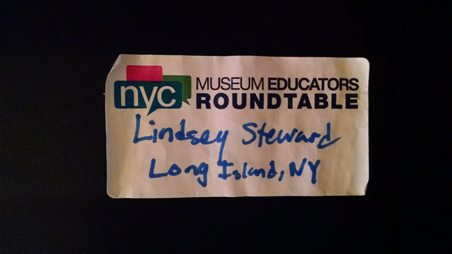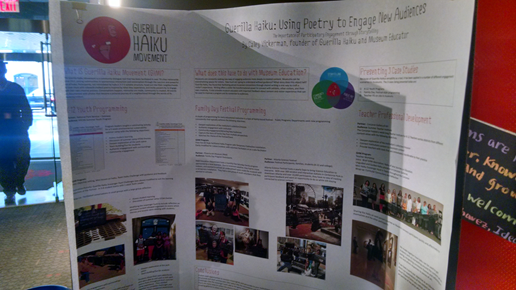Originally posted on Medium, March 10, 2017.
This week’s blog post is both a continuation of the previous blog post “How to use Food to Create Relevance in Museums” and a discussion on equity and inclusion in museums. The topic was inspired by a New York City Museum Educators Roundtable (NYCMER) event Lessons in Equity from Culturally-Specific Institutions: Beyond the “Target Program” that took place this week at the Museum of Chinese in America. This panel began with a gallery exploration of the exhibit “Sour, Sweet, Bitter, Spicy: Stories of Chinese Food and Identity in America” and snacks and refreshments were provided based on the exhibit.
The panel was moderated by Stephanie LaFroscia who is the Arts Program Specialist at New York City Department of Cultural Affairs. Each of the panelists who spoke at the program represent culturally-specific institutions and discuss their experiences and challenges of inclusivity and equity. The panelists were Nancy Yao Maasbach (President of the Museum of Chinese in America), Shanta Lawson (Education Director at the Studio Museum in Harlem), Joy Liu (Education Specialist at the National Museum of the American Indian in New York), and Isra el-Bishar (Curator of Education and Public Programming at the Arab American National Museum). While I was listening to the panelists’ experiences, I also thought about how equity and inclusion is discussed in the general museum field. Last month’s Museum magazine issue was dedicated to the topic of equity and inclusion. Also, I recently received my issue of the Journal of Museum Education which includes articles based on the issue’s title “Race, Dialogue and Inclusion” (Volume 42.1, March 2017). By attending this program, I learned more about how to create an environment that is more inclusive as a museum professional.
The program took place at the Museum of Chinese in America (MOCA) located on Centre Street in New York City. The Museum of Chinese in America is an organization that is dedicated to preserving and presenting the history, heritage, culture and diverse experiences of people of Chinese descent in the United States; the museum also promotes dialogue and understanding among people of all cultural backgrounds. The central part of this museum’s mission is the goal to make Chinese American history accessible to the general public. Also, the museum not only promotes the understanding and appreciation of Chinese American arts, culture, and history but it also informs, educates and engages visitors of Chinese American history in the making.
 Museum of Chinese in America
Museum of Chinese in America
After I walked from the subway to the Museum of Chinese in America, I had the opportunity to try the food related to the museum’s exhibit “Sour, Sweet, Bitter, Spicy: Stories of Chinese Food and Identity in America” before the program began. The snacks were provided by Nom Wah Tea Parlor which is a vintage dim sum parlor that dates back to 1920. There was a sample of various dim sum featured on their menu as well as sparkling water and lemonade for beverages.
I had the opportunity to try vegetarian dumplings, scallion pancake, chicken siu mai, and fried sesame ball with lotus paste. Vegetarian dumplings have mixed vegetables and mushrooms in homemade tapioca starch wrappers. Scallion pancakes are made with wheat flour batter mixed with scallions and then the batter is pan-fried. Chicken Siu Mai is minced chicken in wonton wrappers. The fried sesame ball with lotus paste is lotus paste (sweet and smooth filled paste made from dried lotus seeds) that is wrapped in rice flour dough and then wrapped in sesame seeds. Each of these were delicious, and it is different from other Chinese dishes I have had during my lifetime so far. By trying dim sum, I was able to see what authentic Chinese food tastes like and I had the opportunity to appreciate the culture even more than I had before this experience.
Once I finished eating dim sum, I explored the exhibit “Sour, Sweet, Bitter, Spicy: Stories of Chinese Food and Identity in America” which opened on October 6, 2016 and will now close on September 10, 2017 due to its popularity. The exhibit had a large table and chairs around it in the middle of the room which featured plates, utensils, place settings, and ceramic sculptures; this exhibit told stories of thirty-three Chinese and Asian-American chefs. Also, this exhibit weaves together various complex stories through video installations featuring pioneering chefs including Cecilia Chiang, Ken Hom, Anita Lo, Ming Tsai, and Martin Yan; new restaurateurs like Peter Chang, Vivian Ku, and Danny Bowien; and persevering home cooks like Biying Ni, Yvette Lee and Ho-chin Yang.
This video as well as the large table in the center of the room create a tapestry of various stories that tell their experiences with immigration as well as sharing food memories, favorite dishes and cooking inspirations that define the culinary and personal identities of these chefs. The name of this exhibit comes from an expression that not only refers to the balance of flavors that define Chinese cooking but it also refers to the ups and downs of life. As I read each personal story and explored the rest of the museum’s exhibits, I began to understand the Chinese American experience and I was able to see the relevance of how important it is to continue telling stories of and to appreciate various cultures in our nation.
The program began, after spending time in the exhibit, with each representative from culturally-specific institutions describing their institutions’ missions. For instance, Shanta Lawson of the Studio Museum in Harlem stated that the museum, founded in 1968/1969, was created in response to the lack of diversity in the community and fifty years later there is still a long way to go, and was created to support black artists and art education. Nancy Yao Maasbach of the Museum of Chinese in America discussed the Journey Wall which features Chinese immigrant families and talk about how each of the items in their collection (which is about 65,000 items) have value to the museum and the community. Also, Isra el-Bishar of the Arab American National Museum stated that the museum has been around for twelve years and continues to fulfill its mission by finding ways to represent individuals’ narratives from each Arab country. At the conclusion of the program, after answering various questions from the moderator and people in the audience, each panelist discussed how their respective organizations move forward towards inclusion and equity.
Lawson, for instance, stated that the Studio Museum in Harlem staff plan to continue challenging themselves on how to push forward and challenge norms to see what works and what doesn’t work. Joy Liu of the National Museum of the American Indian in New York discussed the opportunity to include other indigenous peoples’ stories (Latin American indigenous groups), integrate indigenous history, and answer the question what does it mean to be indigenous today? Liu also stated that it is important to emphasize that indigenous peoples’ stories continue to this day, and make sure the truth about indigenous people (indigenous people are the majority in North America for example) is told. Also, Maasbach stated that the museum will use technology more to help visitors understand stories in a way people of different cultures can understand what they did not experience (such as the chair to simulate interrogation of twelve-year-old that was separated from family on Angel Island, California). This program made me think more about equity and inclusion, especially how it is discussed by organizations such as the American Alliance of Museums and the Museum Education Roundtable.
The American Alliance of Museums publishes Museum a magazine that publishes articles written by museum professionals and by writers who write about topics that help museum professionals run their museums. As an AAM member, I have the opportunity to subscribe to this magazine. The previous issue, January/February 2017, main topic was “Equity in the Museum Workforce”, and each article was written with this topic in mind. For instance, there is an article written by Elizabeth Merritt (founding director of the Center for the Future of Museums [CFM]) called “Taking the Bias out of Hiring” which discusses identifying and eliminating unconscious bias in the recruitment process. Another article is “We’re Not That Hard to Find: Hiring Diverse Museum Staff” by Joy Bailey-Bryant (who is responsible for the U.S. operations of Lord Cultural Resources) which presents a set of guidelines to implement change in the museum and identify a pipeline of diverse employees.
Museum Education Roundtable’s publication Journal of Museum Education presents articles written by museum education professionals and museum professionals to discuss current trends and practices in museum education. This month’s journal is on the topic of “Race, Dialogue, and Inclusion: A Museum on the National Stage” and it is broken down into a few sections. The Journal starts with an editorial from Cynthia Robinson, editor-in-chief, and then moves on to an article from guest editors and additional articles from various museum professionals; the Journal also includes a section Tools, Frameworks, and Case Studies which provide exercised examples of how the topic can be addressed in the museum, and What the Research Says which is a research study. I will also be participating in AAM’s discussion on Race, Dialogue and Inclusion based on this month’s Journal of Museum Education so I will discuss this one in further detail. I leave you with these questions to ponder on:
What is your museum/organization doing to move forward on equity and inclusion? Have you read any of the above articles and journal I referred to? If so, what do you think?
 Rainy Train Ride into the City
Rainy Train Ride into the City
 Puppies I saw while looking for a place to eat for lunch
Puppies I saw while looking for a place to eat for lunch Guerilla Haiku Movement Poster, Poster Session
Guerilla Haiku Movement Poster, Poster Session Haiku I created during Poster Session
Haiku I created during Poster Session Museum of Chinese in America
Museum of Chinese in America